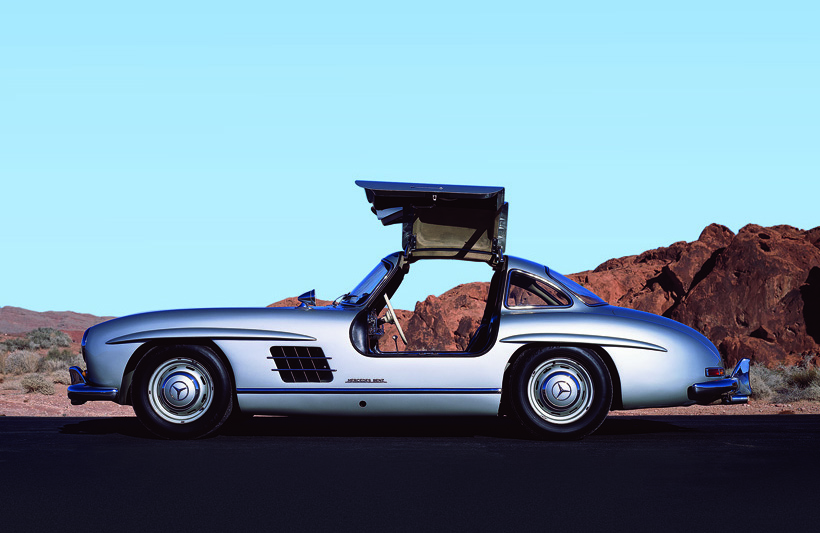 Oh … to have had $6,000 to $8,000 back in the early 1950s with which to buy one of these SL dream machines from the showroom … and then to have kept it for the intervening 56-65 years. But that is another story; this article is to help you understand how 300SLs have moved from sporty enthusiasts’ cars to rolling works of art for collectors, as well as some significant caveats if you are seriously interested in owning either model.
Oh … to have had $6,000 to $8,000 back in the early 1950s with which to buy one of these SL dream machines from the showroom … and then to have kept it for the intervening 56-65 years. But that is another story; this article is to help you understand how 300SLs have moved from sporty enthusiasts’ cars to rolling works of art for collectors, as well as some significant caveats if you are seriously interested in owning either model.
Automotive Icons
W198 300SL Coupe & Roadster • 1954-1963
Article Richard Simonds, Gary Anderson
Images Daimler Archives
Data Tables Daniel Stahl
At the end of World War II, workers, engineers and managers began filtering back to the bomb-blasted factories of Mercedes-Benz, united in their commitment to rebuild the devastated company. By late 1946, in an extraordinary effort, teams of workers had cleared away tons of rubble, assembled surviving machinery and started postwar vehicle production. Beginning in 1951, as a considered first step toward regaining pre-eminence, Mercedes-Benz introduced the elegant 300-series of luxury sedans, cabriolets, coupes and roadsters (see Buyers Guide, The Star March-April 2019).
The next step along the road to recovery came in 1952 when Mercedes-Benz returned to motorsports, constructing the first of the famous 300SLs for competition (see “Glory Days” beginning on page 32 of this issue) and utilizing engine and drivetrain components of the 300 range. Racing successes soon led U.S. distributor Max Hoffman to order 1,000 production 300SL coupes – popularly named “Gullwing” because of their doors; the first customer cars were sold in 1954.
With 1,400 examples of the 300SL coupe sold by 1957, Mercedes-Benz then replaced the hardtop model with an improved roadster, which was later available with a removable hardtop. Nearly 1,900 roadsters were sold before production ended in 1963.
Oh … to have had $6,000 to $8,000 back in those days with which to buy one of these dream machines from the showroom … and then to have kept it for the intervening 56-65 years. But that is another story; this article is to help you understand how 300SLs have moved from sporty enthusiasts’ cars to rolling works of art for collectors, as well as some significant caveats if you are seriously interested in owning either model.
Reasons to buy a 300SL
You get to enjoy owning one of the world’s most iconic cars and look at it any time you want to.
You get to drive it almost any time you want, though we should note that snow, heavy rain, and hail are not the 300SL’s friend. The Gullwing quickly turns any routine errand into a show-and-tell one-vehicle car show; the roadster will capture those “What is that car?” questioning glances from other drivers.
The 300SL is a very reliable and comfortable car to drive on long-distance tours or rallies and would never be turned down from an application-only luxury classic-car tour.
Many routine maintenance jobs are within the reach of an enthusiast with reasonable skills.
Multiple repair and restoration experts are available throughout the United States and Canada for major maintenance, parts or restoration.
The Gull Wing Group International is an incredible club for camaraderie and information. The Group also has a team that has sourced parts that are not otherwise easily available.
Reasons not to buy a 300SL
Both Coupe and Roadster are very expensive to buy and expensive to properly maintain.
At today’s current market prices of $1-2 million, some newer owners are uncomfortable driving their 300SLs for fun, and that’s a shame: These cars were designed and built to be driven and enjoyed.
The Gullwing Coupe’s swing-axle rear suspension can cause inexperienced drivers to abruptly lose control when driving aggressively – especially cornering – and beyond their capability. The low-pivot rear suspension on the roadster is less prone to having a rear wheel tuck under in aggressive cornering, but caution is still advised until you are familiar with the handling of your model.
One of the few weak points of the design is that the passenger compartments of both models don’t provide adequate ventilation. Even with the door windows removed in the coupe or the top down on the Roadster, passengers can quickly become uncomfortably warm in hot weather.
Checkpoints
Considering the entry cost and investment value of these cars, if you’re in the market for one, get a knowledgeable expert to advise you before purchase. Your specialist will know how to look carefully for evidence of body and frame damage.
Repairing the space frame of a 300SL that has been in an accident can be done, but only by an experienced shop; it won’t be cheap. Most body parts have not been available for years; except for the doors, hood, trunk lid and rocker panels, the body is welded as one piece. Again, repair work can be done to very high standards, but at a cost.
Most replacement mechanical parts are available, but they’re very expensive. Mechanical fuel injection can damage the cylinders and crankshaft-connecting rod bearings with raw fuel flow if all components are not working properly; be certain to have the engine checked.
Rust and corrosion can be damaging to the engine if proper antifreeze or coolant has not been used or if the engine has not been run regularly; lack of use affects the fuel-injection system, including the injection pump, fuel injectors and other fuel-injection system components. A vital note: Ethanol is very corrosive to older fuel systems, and many components can be damaged when the car is not used regularly. Ethanol absorbs water and the longer an automobile sits unused, the more damage is likely to be done; the alcohol is extremely damaging to rubber components.
Brake systems can be damaged if the glycol-based brake fluid is not changed and the brakes bled every two years. Glycol absorbs water and can corrode brake cylinders, seals and brake hoses. Replacement parts are expensive.
In-depth knowledge of an individual car’s history – ownership, regular maintenance, repairs and who performed them, and any restoration(s) – is critical to a successful purchase. Get records of everything that you can.
Buying tips
As a first step, join the Gull Wing Group International. Many of the world’s top experts on the 300SL participate in the Gull Wing Group Talk forum and have a wealth of knowledge that they are very willing to share with other group members at www.gullwinggroup.org.
Also be sure to arrange for an expert’s guidance if you are seriously considering acquiring one of these rare and complex cars. Making a mistake can be very costly.
In the past few years, examples of apparently original and barn-find 300SLs have sold for nearly the same price as fully restored and well-maintained cars, illustrating the currency of the belief that “it is only original once.” Caveat Emptor! Know exactly why you would want to purchase a car that needs everything compared with a car that is in good to excellent condition.
Finally
While we all may admire these iconic postwar Mercedes-Benz machines, if you are in the fortunate position of being able to purchase a 300SL coupe or roadster with the advice and guidance of an experienced owner or specialist, one of the most rewarding experiences available to a classic-car owner awaits you.






The Friedrich Geiger-designed 300SL Coupe and Roadster shared a racing-inspired tubular-frame chassis, a powerful fuel-injected engine and four-wheel independent suspension. The most technically advanced road cars of their era, the 300SLs embodied both automotive elegance and performance, capturing the public’s imagination like no other vehicles.


The 300SL roadster debuted at the Geneva Motor Show in March 1957 in response to Max Hoffman’s request for an open-top vehicle for the U.S. market. Changes to the tubular space frame made it possible to fit normal doors. For improved handling, the roadster enployed the single-joint low-pivot swing axle from the 220a, equipped with a compensating spring.


